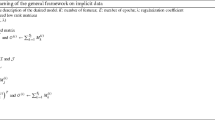Abstract
Ubiquitous recommender systems facilitate users on-location by personalized recommendations of items in the proximity via mobile devices. Due to a high variability of situations and preferences, an efficient resource processing is needed in order to assist the user in a proper way. In this paper, we consider a recommender system, able to learn preferences/habits of users through contextual information, such as location and time, using a new offline model-free approximate Q-iteration. Following the basic idea of Fitted Q-Iteration, the paper focuses on a computational scheme, based on functional networks, and that, unlike the well-known neural ones, does not require a large number of training samples. A preliminary case study, which deals with a shopping mall, is useful to show the approximation capabilities of the proposed approach.




Similar content being viewed by others
References
Acampora G, Gaeta M, Tomasiello S (2013) An extended functional network model and its application for a gas sensing system. Soft Comput 17(5):897–908
Adomavicius G, Tuzhilin A (2008) Context-aware recommender systems. In: Proceedings of the 2008 ACM conference on recommender systems, pp 335–336
Alonso-Betanzos A, Sanchez-Marono N, Carballal-Fortes FM, Suarez-Romero J, Perez-Sanchez B (2007) Classification of computer intrusions using functional networks: a comparative study. In: Proceedings of European symposium on artificial neural networks
Antos A, Munos R, Szepesvari C (2008) Fitted Q-iteration in continuous action-space MDPs. Adv Neural Inf Process Syst 20:9–16
Baltrunas L (2008) Exploiting contextual information in recommender systems. In: Proceedings of the 2008 ACM conference on recommender systems, pp 295–298
Bruen M, Yang J (2005) Functional networks in real-time flood forecasting: a novel application. Adv Water Resour 28:899–909
Castillo E (1998) Functional networks. Neural Process Lett 7:151–159
Castillo E, Cobo A, Gutiérrez JM, Pruneda E (1998) Working with differential, functional and difference equations using functional networks. Appl Math Model 23(2):89–107
Castillo E, Gutiérrez JM, Cobo A, Castillo C (2000) A minimax method for learning functional networks. Neural Process Lett 11(1):39–49
Castillo E, Iglesias A, Ruiz-Cobo R (2005) Funct Equ Appl Sci. Elsevier, Amsterdam
David VK, Rajasekaran S (2009) Pattern recognition using neural and functional networks. In: Studies in computational intelligence, 160. Springer, Berlin
Dey AK, Abowd GD, Salber D (2001) A conceptual framework and a toolkit for supporting the rapid prototyping of context-aware applications. Hum Comput Interact 16:97–166
El-Sebakhy EA (2008) New computational intelligence paradigm for estimating the software project effort. In: Proceedings of international conference on advanced information networking and applications (AINA)
El-Sebakhy EA, Hadi AS, Faisal KA (2007) Iterative least squares functional networks classifier. IEEE Trans Neural Netw 18(3):844–850
Ernst D, Geurts P, Wehenkel L (2005) Tree-based batch mode reinforcement learning. J Mach Learn Res 6:503–556
Fang B, Liao S, Xu K, Cheng H, Zhu C, Chen H (2012) A novel mobile recommender system for indoor shopping. Expert Syst Appl 39(15):11992–12000
Fano AE (1998) Shopper’s eye: using location-based filtering for a shopping agent in the physical world. In: AGENTS ’98 proceedings of the second international conference on autonomous agents, pp 416–421
Gaeta M, Loia V, Tomasiello S (2013) A generalized functional network for a classifier-quantifiers scheme in a gas-sensing system. Int J Intell Syst 28(10):988–1009
Gaeta M, Loia V, Miranda S, Tomasiello S (2016) Fitted Q—iteration by functional networks for control problems. Appl Math Model (to appear)
Gediminas A, Tuzhilin A (2005) Toward the next generation of recommender system: a survey of state-of the-art and possible extensions. IEEE Trans Knowl Data Eng 17(6):149–156
Gordon GJ (1995) Online fitted reinforcement learning. In: VFA workshop at ML-95
Helmy T, Fatai A (2010) Hybrid computational intelligence models for porosity and permeability prediction of petroleum reservoirs. Int J Comput Intel Appl 9(4):313–337
Iglesias A, Arcay B, Cotos JM, Taboada JA, Dafonte C (2004) A comparison between functional networks and artificial neural networks for the prediction of fishing catches. Neural Comput Appl 13:24–31
Lacruz B, Perez-Palomares A, Pruneda RE (2006) Functional networks for classification and regression problems. In: Proceedings of international conference on mathematical and statistical modeling in Honor of Enrique Castillo
Mahmood T, Mujtaba G, Venturini A (2014) Dynamic personalization in conversational recommender systems. Inf Syst E-Bus Manag 12(2):213–238
Mahmood T, Ahmed SH, Mahmood S (2010) Comparing reward-based optimal behaviors in user-adapted recommender systems. In: Proceedings of 3rd IEEE international conference on computer science and information technology, vol 5, pp 332–336
Mettouris C, Papadopoulos GA (2014) Ubiquitous recommender systems. Computing 96(3):223–257
Neumann G, Peters J (2008) Fitted Q-iteration by advantage weighted regression. Adv Neural Inf Process Syst 21:1177–1184
Ormoneit D, Sen S (2002) Kernel-based reinforcement learning. Mach Learn 49:161–178
Press WH, Teukolsky SA, Vetterling WT, Flannery BP (1992) Numerical recipes in C: the art of scientific computing, 2nd edn. Cambridge University Press, New York
Pruneda RE, Lacruz B, Solares C (2005) A first approach to solve classification problems based on functional networks. In: Artificial neural networks: formal models and their applications. Lecture notes in computer science—ICANN, vol 3697, pp 313–318
Rajasekaran S, Thiruvenkatasamy K, Lee T-L (2006) Tidal level forecasting using functional and sequential learning neural networks. Appl Math Model 30:85–103
Resnick P, Varian HR (1997) Recommender systems. Commun ACM 40(3):56–58
Riedmiller M (2005) Neural fitted Q-iteration—first experiences with a data efficient neural reinforcement learning method. In: Machine learning: ECML 2005, Volume 3720 of the series Lecture Notes in Computer Science, pp 317–328
Riedmiller M, Braun H (1993) A direct adaptive method for faster backpropagation learning: The RPROP algorithm. In: Proceedings of the IEEE international conference on neural networks (ICNN)
Sanchez-Marono N, Alonso-Betanzos A (2007) Feature selection based on sensitivity analysis. In: Lecture notes in computer science—12th conference Spanish association for artificial intelligence and its associated conference on technology transfer on artificial intelligence (CAEPIA/TTIA), vol 4788, pp 239–248
Singh S, Litman D, Kearns M, Walker M (2002) Optimizing dialogue management with reinforcement learning: experiments with the NJFun system. J Artif Intell Res 16:105–133
Sutton RS, Barto AG (1998) Reinforcement learning: an introduction. MIT Press, Cambridge
Taghipour N, Kardan A (2008) A hybrid web recommender system based on Q-learning, In: SAC ’08 proceedings of the 2008 ACM symposium on applied computing, pp 1164–1168
Timmer S, Riedmiller M (2007) Fitted Q–iteration with CMACs. In: Proceedings of IEEE international symposium on approximate dynamic programming and reinforcement learning (ADPRL)
Tomasiello S (2011) A functional network to predict fresh and hardened properties of selfcompacting concretes. Int J Numer Methods Biomed Eng 27(6):840–847
Watkins CJCH, Dayan P (1992) Q-learning. Mach Learn 8:279–292
Zhou Y, He D-X, Nong Z (2005) Application of functional networks tosolving classification problems. World Acad Sci EngTechnol 12:71–74
Author information
Authors and Affiliations
Corresponding author
Ethics declarations
Conflict of interest
All the authors declare that they have no conflict of interest.
Human and animals rights
This article does not contain any studies with human participants or animals performed by any of the authors.
Additional information
Communicated by V. Loia.
Rights and permissions
About this article
Cite this article
Gaeta, M., Orciuoli, F., Rarità, L. et al. Fitted Q-iteration and functional networks for ubiquitous recommender systems. Soft Comput 21, 7067–7075 (2017). https://doi.org/10.1007/s00500-016-2248-1
Published:
Issue Date:
DOI: https://doi.org/10.1007/s00500-016-2248-1




